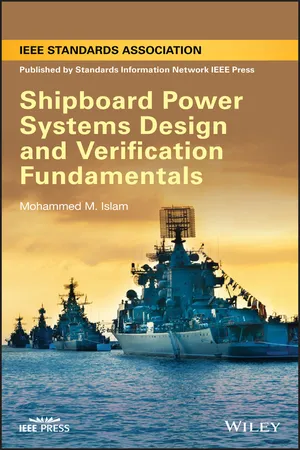
- English
- ePUB (mobile friendly)
- Available on iOS & Android
Shipboard Power Systems Design and Verification Fundamentals
About This Book
The only book that covers fundamental shipboard design and verification concepts from individual devices to the system level
Shipboard electrical system design and development requirements are fundamentally different from utility-based power generation and distribution requirements. Electrical engineers who are engaged in shipbuilding must understand various design elements to build both safe and energy-efficient power distribution systems. This book covers all the relevant technologies and regulations for building shipboard power systems, which include commercial ships, naval ships, offshore floating platforms, and offshore support vessels.
In recent years, offshore floating platforms have been frequently discussed in exploring deep-water resources such as oil, gas, and wind energy. This book presents step-by-step shipboard electrical system design and verification fundamentals and provides information on individual electrical devices and practical design examples, along with ample illustrations to back them.
In addition, Shipboard Power Systems Design and Verification Fundamentals:
- Presents real-world examples and supporting drawings for shipboard electrical system design
- Includes comprehensive coverage of domestic and international rules and regulations (e.g. IEEE 45, IEEE 1580)
- Covers advanced devices such as VFD (Variable Frequency Drive) in detail
This book is an important read for all electrical system engineers working for shipbuilders and shipbuilding subcontractors, as well as for power engineers in general.
Frequently asked questions
Information
Chapter 1
Overview
1.0 INTRODUCTION
- Basic design process, verification, and validation
- Modeling and simulation-based design and verification
- Smart ship system design (S3D)
- Optimize the performance of the shipboard power system
- Optimize the functionality of the shipboard electrical network
- Define the requirements of electrical power equipment
- Define and coordinate the protective devices
- Reduce power losses
- Quantify harmonics contents and then systematically apply a harmonic management program to achieve an acceptable level
- Arc flas...
Table of contents
- Cover
- Title Page
- Copyright
- Dedication
- Preface
- Chapter 1 Overview
- Chapter 2 Electrical System Design Fundamentals and Verifications
- Chapter 3 Power System Design, Development, and Verification
- Chapter 4 Power Generation and Distribution
- Chapter 5 Emergency Power System Design and Development
- Chapter 6 Protection and Verification
- Chapter 7 Power Quality: Harmonics
- Chapter 8 Shipboard Cable Application and Verification
- Chapter 9 Grounding, Insulation Monitoring Design, and Verification
- Chapter 10 Shore Power LV and MV Systems
- Chapter 11 Smart Ship System Design (S3D) and Verification
- Chapter 12 Electrical Safety and Arc Flash Analysis
- Glossary
- Index
- End User License Agreement